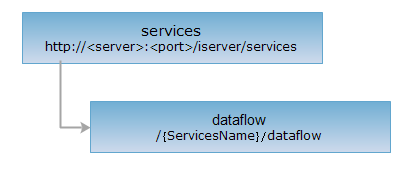
<services_uri>/{servicename}/dataflow[.<format>]
The dataflow resource represents root node of data stream services, which is the entrance of data services. {ServiceName} Service Name specified when publish data stream service.
Supported Methods:
Supported output formats:rjson, json, html, xml.

Implement the HTTP request on the following URI, where supermapiserver is the server name, with rjson being the output format.
http://supermapiserver:8090/iserver/services/{ServiceName}/dataflow.rjson
Gets the entrance of data stream services.
| Field | Type | Description |
| capabilities | String | data stream service capabilities. |
| featureMetaData | String | meta data. |
| StreamUrls | String | data stream service urls. |
The returned rjson format representation after implementing the GET request on the dataflow resource http://supermapiserver:8090/iserver/services/datacatalog/rest/datacatalog/binary.rjson is as follows:
{
"capabilities": "broadcast,subscribe",
"featureMetaData": {
"epsg": 3857,
"featureType": "Point",
"fieldInfos": [
{
"name": "id",
"type": "TEXT"
},
{
"name": "direction",
"type": "INT32"
},
{
"name": "originLabel",
"type": "TEXT"
},
{
"name": "destinationLabel",
"type": "TEXT"
},
{
"name": "groundspeed",
"type": "INT32"
},
{
"name": "x",
"type": "DOUBLE"
},
{
"name": "y",
"type": "DOUBLE"
},
{
"name": "z",
"type": "DOUBLE"
},
{
"name": "datetime",
"type": "TEXT"
}
],
"idFieldName": "id"
},
"streamUrls": [{
"transpot": "ws",
"url": "ws://192.168.17.116:8091/iserver/services/data/dataflow/"
}]
}
Asks for the response identical to the one that would correspond to a GET request, but without the response body. This is useful for retrieving meta-information written in response headers, without having to transport the entire content. The meta-information includes the media-type, content-encoding, transfer-encoding, content-length, etc.
HEAD request can be used to check whether the dataflow resource exists, or whether the the client has the permission to access it. It can also determine if the dataflow resource supports an output format <format> if performed on a URI with .<format> included.
Build a WebSocket connection, where supermapiserver is the server name
ws://supermapiserver:8800/iserver/services/{ServiceName}/dataflow